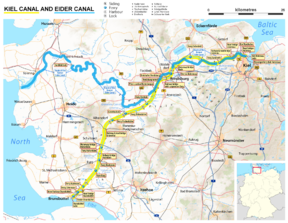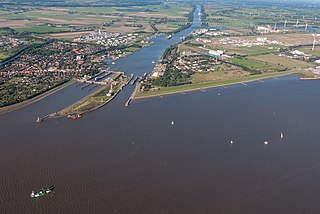
The Kiel Canal is a 98 km (61 mi) long freshwater canal in the German state of Schleswig-Holstein. The canal was finished in 1895, but later widened, and links the North Sea at Brunsbüttel to the Baltic Sea at Kiel-Holtenau. An average of 460 km (290 mi) is saved by using the Kiel Canal instead of going around the Jutland Peninsula. This not only saves time but also avoids storm-prone seas and having to pass through the Danish straits.
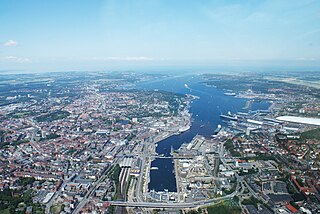
Kiel is the capital and most populous city in the northern German state of Schleswig-Holstein, with a population of 246,243 (2021).

Rendsburg is a town on the River Eider and the Kiel Canal in the central part of Schleswig-Holstein, Germany. It is the capital of the Kreis (district) of Rendsburg-Eckernförde. As of 2006, it had a population of 28,476.
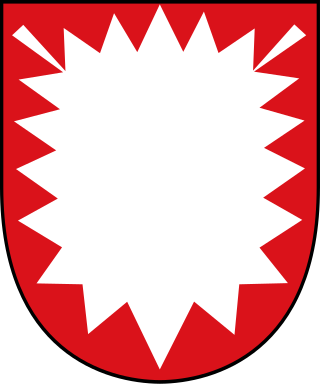
Holstein is the region between the rivers Elbe and Eider. It is the southern half of Schleswig-Holstein, the northernmost state of Germany.
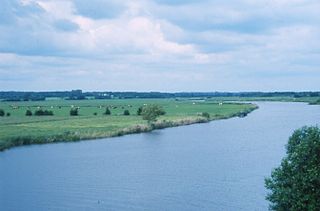
The Eider is the longest river in the German state of Schleswig-Holstein. The river starts near Bordesholm and reaches the southwestern outskirts of Kiel on the shores of the Baltic Sea, but flows to the west, ending in the North Sea. The lower part of the Eider was used as part of the Eider Canal until that canal was replaced by the modern Kiel Canal.

The Bay of Kiel or Kiel Bay is a bay in the southwestern Baltic Sea, off the shores of Schleswig-Holstein in Germany and the islands of Denmark. It is connected with the Bay of Mecklenburg in the east, the Little Belt in the northwest, and the Great Belt in the North.
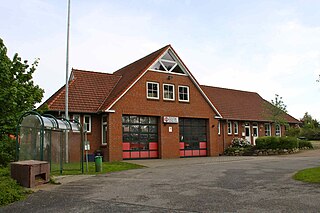
Achterwehr is a municipality, located in the district of Rendsburg-Eckernförde in the German Bundesland of Schleswig-Holstein.

Bovenau is a village in the district of Rendsburg-Eckernförde, in the German state of Schleswig-Holstein. Bovenau is only 16 metres (52 ft) above sea level. The location is south of the municipality of Bünsdorf or Sehestedt, but north of Ostenfeld, Bredenbek, and west of Krummwisch, about 20 km (12 mi) away from the center of Kiel.
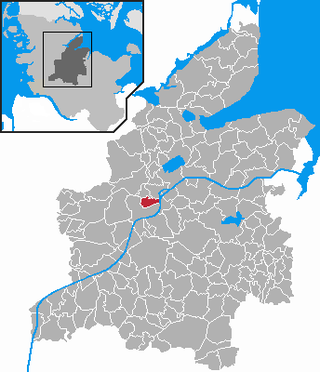
Büdelsdorf is a town in the district of Rendsburg-Eckernförde, in Schleswig-Holstein, Germany. It is situated on the river Eider and the Kiel Canal, approx. 2 kilometres north of Rendsburg, and 30 km (19 mi) west of Kiel, just 5 mi (8 km) off the motorway.

The Danish Wahld is a peninsula in Schleswig-Holstein, Germany. It is located between Eckernförde Bay in the north and Kiel Fjord in the south. The Amt of "Dänischer Wohld" in the district of Rendsburg-Eckernförde is named after the peninsula, but only encompasses a central part of the region.

The Stecknitz Canal was an artificial waterway in northern Germany which connected Lauenburg and Lübeck on the Old Salt Route by linking the tiny rivers Stecknitz and Delvenau, thus establishing an inland water route across the drainage divide from the North Sea to the Baltic Sea. Built between 1391 and 1398, the Stecknitz Canal was the first European summit-level canal and one of the earliest artificial waterways in Europe. In the 1890s the canal was replaced by an enlarged and straightened waterway called the Elbe–Lübeck Canal, which includes some of the Stecknitz Canal's watercourse.

The Treene is a river, hydrologically 95 km (59 mi) and nominally 73.4 km (45.6 mi) long, in Southern Schleswig in the north of Schleswig-Holstein, Germany. It is a right-bank tributary of the River Eider. It starts in northern Angeln, southeast of Flensburg, and flows mainly south-south-west before joining the Eider near Friedrichstadt.

The Duchy of Holstein was the northernmost state of the Holy Roman Empire, located in the present German state of Schleswig-Holstein. It originated when King Christian I of Denmark had his County of Holstein-Rendsburg elevated to a duchy by Emperor Frederick III in 1474. Members of the Danish House of Oldenburg ruled Holstein – jointly with the Duchy of Schleswig – for its entire existence.

Kieler Förde is an inlet of the Baltic Sea, approximately 17 km (11 mi) long, on the eastern side of Schleswig-Holstein, Germany. Formed by glacial movement during the last ice age, it divides Danish Wold peninsula from Wagria. Like the other inlets of förde-type, geologically it is not a fjord. It originates at the Hörn in centre-city Kiel and merges into the Bay of Kiel.

Schülp bei Rendsburg is a municipality in the district of Rendsburg-Eckernförde, in Schleswig-Holstein, Germany.

Westerrönfeld is a municipality in the district of Rendsburg-Eckernförde, in Schleswig-Holstein, Germany. The name literally means "The field west of the Rön", the Rön being a little tributary of the river Eider. Westerrönfeld is located on the southern bank of the Kiel Canal.

The Neumünster Flensburg Railway is part of the Jutland line, the main north–south rail link through Schleswig-Holstein, Germany. Together with the line to Husum, which diverges in Jübek, and the line to Kiel, which diverges in Rendsburg, it also serves as an important east–west axis between Kiel and the Marsh Railway on the west coast. It consists of several sections that were parts of the first railways in the current territory of Germany.
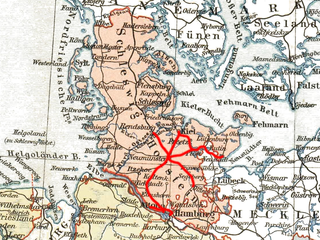
The Altona-Kiel Railway Company was a joint-stock company, established under the law of Denmark in personal union with the Duchy of Holstein, that built and operated an 105 km railway line between Altona and the Baltic Sea port city of Kiel. Altona was at that time the second largest city under Danish rule and the railway line was the first built in Danish-controlled territory.

Holtenau is a district of Kiel, on the southeastern part of the Danish Wahld. It was historically part of the Duchy of Schleswig, and has cultural influences from both Germany and Denmark.
